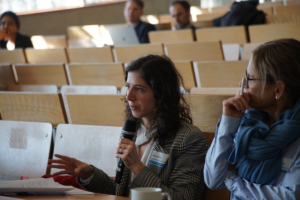Who’s Afraid of Punitive Damages? – Conference in Augsburg, Germany
by Salih Okur (University of Augsburg)
On 8 and 9 March, scholars from more than a dozen different jurisdictions followed the invitation of Tobias Lutzi to discuss recent trends in punitive damages at the University of Augsburg, Germany. Despite an unfortunate combination of rail and flight strikes, only a small number of participants were ultimately unable to make it to Augsburg. While their presence was dearly missed, the option of participating in the conference online meant that nothing stood in the way of more than 50 scholars of private and private international law devoting the next 26 hours to critically discuss whether and to what extent a strict refusal to recognise foreign punitive damage awards – as notably upheld in Germany – was still tenable in light of international developments.

The conference contained five panels overall, which were split into three blocks. It was kicked off by Tobias Lutzi and Marc Lendermann (Federal Ministry for Digital and Transport, Germany), who underlined the continued relevance of punitive damages as a research topic, despite the German Federal Court of Justice’s landmark decision from 1992 (BGHZ 118, 312), which appears to have stopped claimants from seeking enforcement of punitive damage awards in Germany. It evidently has not stopped claimants from seeking enforcement of punitive damage awards in other civil law legal systems. As the conference would highlight on the second day, some legal systems, including Italy, France, and South Korea, which originally refused to recognise foreign decisions on grounds similar to those of the German Federal Court of Justice (BGH), have abandoned their strict refusal and adopted a more nuanced approach. This constant flow of international change and developments alone makes it worthwhile to keep the academic conversation going.
The first block then focused on the origin, scope, and, particularly, on the purpose of punitive damage awards. In his paper on “Compensation, Punishment, and the Idea of Private Law”, Lukas Rademacher (University of Kiel) explained the idea of punitive damages and its compatibility with German private law. Rademacher took a closer look at the BGH’s landmark decision from 1992, which deemed the concept of punitive damages intolerable in Germany mainly because its function to punish and deter doesn’t fall in the scope of German private law’s concept of strict compensation; punishment and deterrence are entirely reserved for criminal law. Rademacher then analysed whether punitive elements could be found in German tort law. He identified damage awards for pain and suffering and loss of personality as potential examples of over-compensatory remedies in German private law. Rademacher explained that these awards, when not relating to an actual loss, still serve semi-compensatory interests, especially the idea of satisfaction. In contrast to punitive damages, these interests aren’t objective sanctions detached from compensation, as they are still a means to restore an infringed right and restore equality between the tortfeasor and the injured party.

Subsequently, Jan Lüttringhaus (University of Hanover) focused on “Punitive Damages and Insurance”, picking up the BGH’s concerns regarding the insurability of punitive damage awards (which the Court deemed an incalculable and uninsurable risk). Lüttringhaus immediately dismissed these concerns, as the numbers necessary for insurability exist. According to him, data on punitive damages is well documented, delivering the required statistical data on frequency and severity of loss, which allows the inference of an average loss and therefore an adequate premium. Lüttringhaus then addressed the much more fundamental question of whether punitive damages should be insurable, as this could impede their punishing and deterrent character. On the other hand, insurability could guarantee payment where the defendant lacks the financial capacity, and the punitive and deterrent effect could still be achieved by imposing higher premiums and the tortfeasor having difficulties finding a new insurer.
Catherine Sharkey (New York University) then shifted the conference’s focus away from the stereotypical punitive damage award for intentional malicious conduct and shed light on the question, “Who’s Afraid of Punitive Damages for Product Liability?”. She observed that punitive damages in the U.S. are awarded much more often against corporations and businesses for not keeping up with safety standards than against individuals for intentional malicious conduct. Thus, it seems hard to sustain the idea of retribution when discussing punitive damages, as with corporations and businesses, there is “no soul to damn and no body to kick”. Sharkey explained that the idea of societal deterrence and compensation was taking on a more predominant role. This paradigm shift could also be observed in proposals to focus more on what is necessary to achieve adequate deterrence when deciding on whether and how much to award in cases in which punitive damages are a possibility. This idea of social deterrence was further perpetuated, according to her, when considering that many states have implemented split recovery statutes for product liability cases that direct 50 % to 75 % of punitive damage awards to the respective state or a designated fund.
Concluding the first panel (and day) of the conference, Rachel Mulheron (Queen Mary University) shared her insights into “Punitive Damages in English Law”. She pointed out that although parliament abolished punitive damages in certain areas of law (e.g. through the Law Reform Act 1934 and the Competition Act 1998), this has not prevented English courts from awarding punitive damages for common law torts such as defamation and trespass to the person, as has been established in Rookes v. Barnard [1964] AC 1129. Still, English courts seem to struggle to differentiate between compensatory and punitive damage awards. While the Court of Appeal in John v. MGN Ltd. [1997] QB 586 expressly allocated the purpose of vindication to the compensatory limb of defamation cases, the Privy Council in A v. Bottril [2002] UKPC 44 ruled that one function of punitive damages was vindication. Beyond that, punitive damages are not readily available for negligence and privacy torts, as there are lingering uncertainties identifying the requisite trigger for punitive damages.
After the foundation was laid on the first day of the conference, the second day opened with a panel on the public policy exception to the recognition and enforcement of foreign judgments. Cedric Vanleenhove (University of Ghent) gave a paper on “Punitive Damages and Public Policy”. He argued that punitive damages seem to be one of the few legal institutions showing a sharp contrast between common law and civil law jurisdictions. The central mechanism for the rejection of common law punitive damage awards is the public policy exception representing the fundamental values of a society, keeping away foreign judgements if they are manifestly unacceptable when measured against domestic legal standards. In search of the “right” approach regarding the enforcement of punitive damage awards, Vanleenhove emphasised legal coherence: the more the private law of a state derogates from full compensation and allows punitive-like damage awards, the harder it appears to sustain the argument that full compensation is part of public policy. Vanleenhove also examined the relevance of the label given to damage awards. Due to the prohibition of révision au fond, the court of enforcement might feel bound to the court of origin’s compensatory label even if the awarded damages are excessive. As could be seen in the Spanish Real Madrid case currently pending at the Court of Justice, excessive compensatory damages might trigger the public policy exception if the enforcement would give rise to a manifest breach of fundamental rights. French courts, on the other hand, seemed to apply a rather general proportionality test.
In the second paper of the day, Marko Jovanovic (University of Belgrade) took a closer look at “The Public Policy Exception in the 2019 Hague Judgements Convention” and compared it to similar exceptions in other instruments. Comparing the public policy exception of the 2019 HCCH Judgements Convention with the 1971 HCCH Judgements Convention, the 2005 HCCH Choice of Court Convention, and the Brussels I Recast Regulation, it stands out that all of them require a manifest incompatibility to trigger the respective exception. Only the 1958 New York Convention seems to waive the high threshold of a manifest incompatibility. Nevertheless, academics as well as practitioners agree on applying this exception restrictively. These high hurdles for triggering the public policy exception speak in favour of its application only to extreme cases. However, Jovanovic reported that some national jurisdictions misused the public policy exception as a barrier against undesirable decisions. As for most of these legal frameworks, there is no international court that oversees the uniform application, so internationalisation seems like a distant goal according to Jovanovic, no matter how desirable it may be.
After this introduction to the public policy exception, the conference entered its third block on the exception’s actual application to punitive damages awards. The first panel was dedicated to the Netherlands (André Janssen (Radboud University)), Japan (Beligh Elbalti (University of Osaka)) and Germany (Johannes Ungerer (University of Oxford)), all of which still refuse recognition and enforcement of foreign punitive damage awards.
 Before going into detail as to why Dutch courts maintain this position, Janssen presented provisions of the Dutch civil code that seem to show punitive elements, e.g., the injured person being entitled to damages for losses, which do not consist of pecuniary damages, if the tortfeasor had the intention of causing such losses. While many Dutch authors recognise punitive elements in these provisions, the Dutch Supreme Court does not share this view and denies the existence of punitive elements. Interestingly, in 2012, the Rechtbank Amsterdam enforced 5,000 € worth of punitive damages, arguing that the fact that Dutch law doesn’t recognise punitive damages does not mean that they are contrary to Dutch public policy. However, in the Hof’s Hertogenbosch case from 2021, a Dutch court denied recognition and enforcement of a punitive damage award because its character was incompatible with the fundamental nature of Dutch liability and compensation law, and beyond that, the award of $250,000 in that case was seen as disproportionate to the compensatory part.
Before going into detail as to why Dutch courts maintain this position, Janssen presented provisions of the Dutch civil code that seem to show punitive elements, e.g., the injured person being entitled to damages for losses, which do not consist of pecuniary damages, if the tortfeasor had the intention of causing such losses. While many Dutch authors recognise punitive elements in these provisions, the Dutch Supreme Court does not share this view and denies the existence of punitive elements. Interestingly, in 2012, the Rechtbank Amsterdam enforced 5,000 € worth of punitive damages, arguing that the fact that Dutch law doesn’t recognise punitive damages does not mean that they are contrary to Dutch public policy. However, in the Hof’s Hertogenbosch case from 2021, a Dutch court denied recognition and enforcement of a punitive damage award because its character was incompatible with the fundamental nature of Dutch liability and compensation law, and beyond that, the award of $250,000 in that case was seen as disproportionate to the compensatory part.
The Japanese Supreme Court, in its Kyogo decision, reached the same conclusion as to the incompatibility of punitive damages with Japanese public policy. The court argued that the purpose of punitive damages was the same as that of criminal law, whereas Japanese tort law seeks only to restore the actual loss suffered by the victim. Based on this fundamental difference, foreign punitive damage awards are considered incompatible with the Japanese civil law system. Although the Supreme Court allowed for partial recognition and enforcement of the compensatory part, claimants cannot enforce the punitive part in the country of origin and eventually enforce the compensatory part in Japan, as Japanese courts then treat the punitive part of the decision as non-existent. Furthermore, Elbalti reported that in the academic debate, it remained unclear whether punitive damages are incompatible with Japanese public policy per se or if aspects of proportionality should be of relevance.
Finally, Ungerer argued that Germany’s rejection of foreign punitive damage awards was the result not of fear but rather of a principled approach. He emphasised the protection of German creditors as enforcing excessive punitive damage awards entails the risk of draining the defendant’s assets at the expense of domestic creditors. He also noted the risk of the defendant who faces a punitive damage award becoming insolvent, potentially leading to the claims of all the other creditors becoming worthless. Ungerer further stressed that Germany’s practice of awarding damages for intangible losses while simultaneously rejecting foreign punitive damage awards does not make Germany guilty of a double standard, as those awards still observe a compensatory relation and limitation, similar to the point made by Rademacher on the first day of the conference. So, according to Ungerer, Germany’s rejection of enforcing punitive damages can be seen as an unafraid and principled measure.
The last panel of the conference was dedicated to France (Samuel Fulli-Lemaire (Université de Strasbourg)), Italy (Caterina Benini (Università Cattolica del Sacro Cuore)) and South Korea (Min Kyung Kim (Incheon District Court)), all of which have recently started to recognise and enforce punitive damage awards under certain circumstances.
Fulli-Lemaire clarified that France was never that afraid of punitive damages. Up until the landmark decision of the Cour de Cassation in 2010, there had been strong academic support for the recognition and enforcement of punitive damage awards. Still, in 2010, the Cour de Cassation, in its Fontaine Pajot case, made clear that this support is not without exception. The public policy exception might still trigger when the amount of punitive damages awarded is disproportionate to the loss sustained and to the severity of the breach of duty. Unfortunately, the Cour de Cassation did not give further guidelines regarding the proportionality test. On top of that, it remains unclear what even qualifies as an award for punitive damages and whether the French courts are bound by the qualifications of the original court. Fulli-Lemaire stressed that one must always keep in mind the prohibition of révision au fond, though.
In contrast to France, Benini reported that Italy was indeed once scared of punitive damages, e.g. when the Italian Supreme Court rejected recognition and enforcement of an Alabamian judgement in 2007, arguing that punitive elements were alien to Italian civil liability. Ten years later, in 2017, the Italian Supreme Court held that the evolution of civil liability, though, still predominantly serving compensation, led to also considering punitive and deterrent purposes. Thus, punitive damages were not ontologically incompatible with Italian public policy. Again, there are conditions the foreign award must comply with in order not to trigger the Italian public policy exception. Namely, the punitive damage award must be reconcilable with the legality (typicality and predictability) and proportionality principles. In Italy, the courts apply the proportionality test by comparing the amount of punitive damages to compensatory damages as well as the severity of the wrongdoer’s conduct.
Similarly to Italy, South Korean courts also rejected the enforcement of punitive damage awards, as the principle of full compensation was part of South Korean public policy. Kim describes that in 2011, the South Korean legislator began introducing acts providing treble, quadruple, and even quintuple damages, softening up the principle of full compensation in South Korean private law. With this in mind, in 2022, the Korean Supreme Court recognised that, at least when the cause of damages in a foreign judgement falls within the purview of this Korean legislation, it was difficult to justify a manifest incompatibility with fundamental principles of South Korean private law, – very much in line with Vanleenhove’s previous call for legal coherence. It remains unclear, though, whether South Korea will eventually overcome its fear of punitive damages more broadly and resort to a more generous proportionality test, similar to France and Italy.
Overall, the conference aptly demonstrated that there is still a lot of comparative legal research to be done in the field of punitive damages. The conference proceedings, which will be published by Mohr Siebeck and will contain extended versions of the papers, will certainly contribute to this endeavour.


